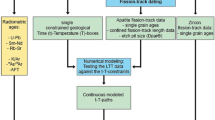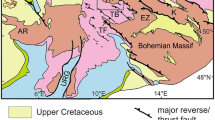Abstract
The Upper Rhine Graben (URG) is the most perceptible part of the European Cenozoic Rift System. Uplifted Variscan basement of the Black Forest and the Vosges forms the flanks of the southern part of the graben. Apatite and zircon fission-track (FT) analyses indicate a complex low-temperature thermal history of the basement that was deciphered by inverse modelling of FT parameters. The models were tested against the observed data and independent geological constraints. The zircon FT ages of 28 outcrop samples taken along an E–W trending transect across the Black Forest and the Vosges range from 136 to 312 Ma, the apatite FT ages from 20 to 83 Ma. The frequency distributions of confined track lengths are broad and often bimodal in shape indicating a complex thermal history. Cooling below 120°C in the Early Cretaceous to Palaeogene was followed by a discrete heating episode during the late Eocene and subsequent cooling to surface temperature. The modelled time–temperature (t–T) paths point to a total denudation of the flanks of URG in the range of 1.0–1.7 km for a paleogeothermal gradient of 60°C/km, and 1.3–2.2 km for a paleogeothermal gradient of 45°C/km since the late Eocene.














Similar content being viewed by others
References
Brandon MT, Roden-Tice MK, Garver JI (1998) Late Cenozoic exhumation of the Cascadia accretionary wedge in the Olympic Mountains, northwest Washington State. Geol Soc Am Bull 110:985–1009
Carlson WD (1990) Mechanisms and kinetics of apatite fission-track annealing. Am Mineral 75:1120–1139
Cloos H (1939) Hebung-Spaltung-Vulkanismus. Geologische Rundschau 30:401–527
Crowley KD, Cameron M, Schaefer RL (1991) Experimental studies of annealing etched fission tracks in fluorapatite. Geochimica et Cosmochimica Acta 55:1449–1465
Dèzes P, Schmid SM, Ziegler PA (2004) Evolution of the Alpine and Pyrenean orogens with their foreland lithosphere. Tectonophysics 389:1–33
Dumitru TA (1993) A new computer-automated microscope stage system for fission-track analysis. Nucl Tracks Radiat Meas 21:575–580
Dunkl I (2002) TRACKKEY: a Windows program for calculation and graphical presentation of fission track data. Comput Geosci 28:3–12
Edel JB, Fluck P (1989) The upper Rhenish Shield basement (Vosges, Upper Rhinegraben and Schwarzwald): Main structural features deduced from magnetic, gravimetric and geological data. Tectonophysics 169:303–316
Foster DA, Gleadow AJW (1996) Structural framework and denudation history of the flanks of the Kenya and Anza Rifts, East Africa. Tectonics 15:258–271
Foster DA, Gleadow AJW, Reynolds SJ, Fitzgerald PF (1993) The denudation of metamorphic core complexes and the reconstruction of the Transition Zone, west central Arizona: constraints from apatite fission track thermochronology. J Geophys Res 98:2167–2185
Foster DA, Raza A (2002) Low-temperature thermochronological record of exhumation of the Bitterroot metamorphic core complex, northern Cordilleran Orogen. Tectonophysics 349:23–36
Fuchs K, Bonjer K-P, Gajewski D, Lueschen E, Prodehl C, Sandmeier K-J, Wenzel F, Wilhelm H (1987) Crustal Evolution of the Rhinegraben area. 1. Exploring rhe lower crust in the Rhinegraben rift by unified geophysical experiments. Tectonophysics 141:261–275
Fügenschuh B, Schmid SM (2003) Late stages of deformation and exhumation of an orogen constrained by fission-track data: a case study in the Western Alps. Geol Soc Am Bull 115:1425–1440
Galbraith RF (1988) Graphical display of estimates having differing standard errors. Technometrics 30:271–281
Galbraith RF (1990) The radial plot: graphical assessment of spread in ages. Nucl Tracks Radiat Meas 17:207–214
Galbraith RF, Laslett GM (1993) Statistical models for mixed fission track ages. Nucl Tracks Radiat Meas 21:459–470
Gallagher K, Brown RW, Johnson C (1998) Fission track analysis and its applications to geological problems. Ann Rev Earth Planet Sci 26:519–572
Geyer OF, Gwinner MP (1991) Geologie von Baden-Württemberg. 4., neubearb Aufl der “Einführung in die Geologie von Baden-Württemberg”. Schweizerbart, Stuttgart
Giamboni M, Ustaszewski K, Schmid SM, Schumacher ME, Wetzel A (2004) Plio-Pleistocene transpressional reactivation of Paleozoic and Paleogene structures in the Rhine-Bresse transform zone (northern Switzerland and eastern France). Int J Earth Sci 93:207–223
Gleadow AJW (1981) Fission track dating: what are the real alternatives. Nucl Tracks Radiat Meas 5:3–14
Gleadow AJW, Brown RW (2000) Fission-track thermochronology and the long-term denudational response to tectonics. In: Summerfield MA (ed) Geomorphology and global tectonics. Wiley, New York, pp 57–75
Green PF (1981) A new look at statistics in fission track dating. Nucl Tracks Radiat Meas 5:77–86
Hurford AJ (1990) International Union of Geological Sciences Subcommission on Geochronology recommendation for the standardization of fission track dating calibration and data reporting. Nucl Tracks Radiat Meas 17:233–236
Hurford A, Carter A (1994) Regional thermo-tectonic histories of the Rhine Graben and adjacent Hercynian basement: a key to assessing the alpine influence in northwest Europe. In: 8th International Conference on Geochronology, Cosmochronology and Isotope Geology, abstracts, p 148
Hurford AJ, Green PF (1982) A users’ guide to fission track dating calibration. Earth Planet Sci Lett 59:343–354
Hurford AJ, Green PF (1983) The zeta age calibration of fission-track dating. Chem Geol 41:285–317
Illies JH (1977) Ancient and recent rifting in the Rhinegraben. Geologie en Mijnbouw 56:329–350
Illies JH, Fuchs K (eds) (1974) Approaches to taphrogenesis. Schweizerbart, Stuttgart, p 460
Illies JH, Müller S (eds) (1970) Graben problems. Schweizerbart, Stuttgart, p 316
Kasuya M, Naeser CW (1988) The effect of α-damage on fission-track annealing in zircon. Nucl Tracks Radiat Meas 14:477–480
Keller J, Kraml M, Henjes-Kunst F (2002) 40Ar/39Ar single crystal dating of early volcanism in the Upper Rhine Graben and tectonic implications. Schweiz Mineral Petrogr Mitt 82:121–130
Ketcham RA, Donelick RA, Carlson WD (1999) Variability of apatite fission-track annealing kinetics III: Extrapolation to geological time scales. Am Mineral 84:1235–1255
Ketcham RA, Donelick RA, Donelick MB (2000) AFTSolve: a program for multi-kinetic modelling of apatite fission track data. Geol Mater Res 2:1–18
Laslett GM, Galbraith RF (1996) Statistical modelling of thermal annealing of fission tracks in apatite. Geochim Cosmochim Acta 60:5117–5131
Laslett GM, Green PF, Duddy IR, Gleadow AJW (1987) Thermal annealing of fission tracks in apatite 2. A quantitative analysis. Chem Geol (Isot Geosci Sect) 65:1–13
Michalski I (1987) Apatit-Spaltspuren-Datierungen des Grundgebirges von Schwarzwald und Vogesen: Die postvariszische Entwicklung. Doctoral dissertation, Heidelberg, p 125
Naeser CW (1976) Fission-track dating. US Geol Surv Open-File Rep 76–190, pp 65
Naeser CW (1979) Thermal history of sedimentary basins: fission track dating of subsurface rocks. In: Scholle PA, Schluger PR (eds) Aspects of diagenesis. Soc Econ Paleontol Mineral Spec Publ, SEPM, Tulsa OK United States, pp 109–112
Paul W (1955) Zur Morphogenese des Schwarzwaldes (I). Jh geol Landesamt Baden-Württ 1:395–427
Price PB, Walker RM (1962a) A new detector for heavy particle studies. Phys Lett 3:113–115
Price PB, Walker RM (1962b) Observations of charged-particle tracks in solids. J Appl Phys 33:3407–3406
Prodehl C, Mueller S, Haak V (1995) The European Cenozoic rift system. In: Olsen KH (ed) Continental rifts: evolution, structure, tectonics. Developments in geotectonics 25. Elsevier, New York, pp 133–212
Raab MJ, Brown RW, Gallagher K, Carter A, Weber K (2002) Late Cretaceous reactivation of major crustal shear zones in northern Namibia: constraints from apatite fission track analysis. Tectonophysics 349:75–92
Rothé JP, Sauer K (eds) (1967) The Rhinegraben progress report 1967. Abh Geol Landesamt Baden-Württemberg 6, pp 146
Schumacher ME (2002) Upper Rhine Graben: role of preexisting structures during rift evolution. Tectonics 21:6-1-17
Tagami T, Shimada C (1996) Natural long-term annealing of the zircon fission track system around a granitic pluton. J Geophys Res 101/B4:8245–8255
Tagami T, Galbraith RF, Yamada R, Laslett GM (1998) Revised annealing kinetics of fission tracks in zircon and geological implications. In: Van den Haute P, De Corte F (eds)Advances in fission track geochronology. Kluwer, Dordrecht, pp 99–112
Timar-Geng Z, Fügenschuh B, Schaltegger U, Wetzel A (2004) The impact of the Jurassic hydrothermal activity on zircon fission track data from the southern Upper Rhine Graben area. Schweiz Mineral Petrogr Mitt 84:257–269
von Gehlen K (1987) Formation of Pb-Zn-F-Ba mineralizations in SW Germany: a status report. Fortschr Miner 65:87–113
Wagner GA (1979) Correction and interpretation of fission track ages. In: Jäger E, Hunziker JC (eds) Lectures in isotope geology. Springer, Berlin Heidelberg New York, pp 170–177
Wagner GA (1990) Apatite fission-track dating of the crystalline basement of Middle Europe: concepts and results. Nucl Tracks Radiat Meas 17:277–282
Wagner GA, Reimer GM, Jäger E (1977) Cooling ages derived by apatite fission track, mica Rb–Sr, and K–Ar dating: the uplift and cooling history of the central Alps. Mem Inst Geol Mineral Univ Padova 30:1–27
Wagner GA, Michalski I, Zaun P (1989) Apatite fission-track dating of the Central European basement: post-Variscian thermotectonic evolution. In: The German Continental Deep Drilling Program (KTB). Springer, Berlin Heidelberg New York, pp 481–500
Werner W, Franzke HJ (2001) Postvariszische bis neogene Bruchtektonik und Mineralisation im südlichen Zentralschwarzwald. Z Dt Geol Ges 152:405–437
Wernicke RS, Lippolt HJ (1997) (U+Th)-He evidence of Jurassic continuous hydrothermal activity in the Schwarzwald basement, Germany. Chem Geol 138:273–285
Wetzel A, Allenbach R, Allia V (2003) Reactivated basement structures affecting the sedimentary facies in a tectonically „quiescent” epicontinental basin: an example from NW Switzerland. Sediment Geol 157:153–172
Wimmenauer W, Schreiner A (1990) Erläuterungen zu Blatt 8114, Feldberg. Geol Karte Baden-Württ 1:25 000, Stuttgart, p 134
Wyss A (2001) Apatit Spaltspur Untersuchungen in der Vorwaldscholle (SW-Deutschland). Unpubl diploma thesis, Univ Basel, p 69
Ziegler PA (1990) Geological atlas of Western and Central Europe. Shell Internationale Petroleum Maatschappij, Geological Society Publishing House, London, p 239
Ziegler PA, Cloething S, van Wees J-D (1995) Dynamics of intra-plate compressional deformation: the Alpine foreland and other examples. Tectonophysics 252:7–59
Acknowledgements
This work has been supported by the Swiss National Science Foundation (Project Nos. 21-57038.99 and 20-64567.01). We thank M. Brix, U.A. Glasmacher and M. Rahn for their constructive comments and suggestions that substantially improved the manuscript.
Author information
Authors and Affiliations
Corresponding author
Appendix
Appendix
Modelling details
This appendix (Tables 4, 5) contains information about parameters used for inverse modelling. The time for the first constraint was chosen based on the consideration that this time should be somewhat earlier than the FT age of the oldest and thus most resistant apatite grains to allow for age reduction by partial annealing (Ketcham et al. 2000). Thus, the temperature for the first constraint was set at ~130°C providing that there are no fission tracks present as an initial condition. Modelled t–T paths were initially defined to be non-monotonic, aiming at finding solutions by the program, particularly any possible heating events and their timing. The initial model runs also constrain the time of cooling below the track retention temperature, which can be used as initial constraints for subsequent model runs. In a next step, the new initial constraint and additional intermediate constraints were used to better evaluate individual heating and cooling events. Model runs were so gradually refined by forcing restrictions on the t–T paths as suggested by consecutive modelling results and geological observations.
Rights and permissions
About this article
Cite this article
Timar-Geng, Z., Fügenschuh, B., Wetzel, A. et al. Low-temperature thermochronology of the flanks of the southern Upper Rhine Graben. Int J Earth Sci (Geol Rundsch) 95, 685–702 (2006). https://doi.org/10.1007/s00531-005-0059-1
Received:
Accepted:
Published:
Issue Date:
DOI: https://doi.org/10.1007/s00531-005-0059-1




